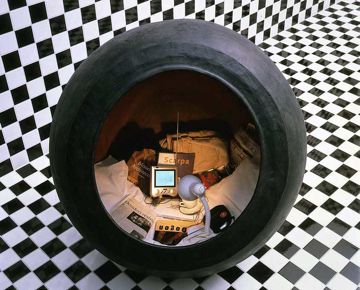
Fred Wilson, "Safe House II, (Speak of Me as I Am)", 2003
I’ve been lucky enough over the past few years to collaborate and work with some fantastic teachers- both in my home district and around the country. Whenever we get to talking about introducing contemporary art in the classroom the conversation ultimately gets around to how we create environments that students feel comfortable in- places where they can freely share ideas and try representing things that don’t exactly fit into a unit on still life, for example. But once we agree on the fact that students need to feel comfortable enough to take risks, the conversation gets much more difficult.
How do we create environments (in classrooms, studios, museums?) where students feel comfortable enough to try things differently, think differently, perhaps even act differently toward each other? What kinds of things can a teacher do to help create these kinds of spaces? Thinking back on these conversations, here are a few examples….
- Give students a place to think on paper…. regularly: Incorporating sketchbooks and having students use them on a consistent basis gives them a place where they become used to thinking things through, saving some ideas for later, and discovering relationships between ideas that never would have surfaced without a sketchbook.
- Encourage work that takes place outside the classroom: Our curriculum, whatever we teach, is the tip of the iceberg. Students who are encouraged to build on things they learn and share new ideas will return to class knowing that their work is valued beyond school itself. They will know that the teacher is paying attention to how their interests outside of class can affect the work inside of class.
- Manage and organize the classroom for minimal distractions and wasted time: Let’s face it, this is the hardest of the three ideas, and perhaps it’s not even an “idea”, but without effective management and organization, classes can literally become too short to complete meaningful work with our students. Teachers need to feel comfortable working with a wide variety of students, managing smooth transitions, differentiating activities and discovering ways of having all students take part in running the class.
The spaces we shape are about the tools we provide, the trust we build, and the way we organize our time, not simply about the sequence of units and the physical environment.



